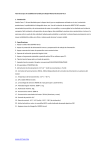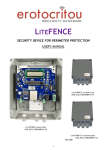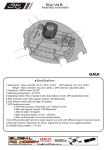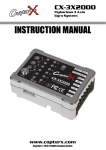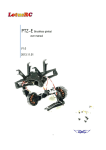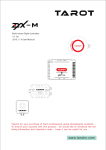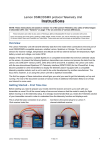Download ZYX-GS Manual, English
Transcript
ZYX-GS Gimbal Stabilization System User Manual v1.0 1. Introduction The new high performance precision gimbal stabilization system ZYX-GS from Tarot provides dedicated independent gimbal control to efficiently and effectively stabilize your AP/AV shots and ideally matched to our new PTZ gimbal and other 3rd party gimbal providers. The ZYX-GS features 3-axis stabilization, adjustable gains (PC), attitude locking and attitude following modes, 3-axis MEMS gyro and accelerometer, free firmware upgrade services. Offering a wide range of servo support and an unbeatable price point, Tarot hopes to continue its trend of supplying quality products to the Heli and Multi-rotor markets at the lowest possible price. ZYX-GS provides two kinds of stabilization control mode, which are attitude locking mode and following (FPV) mode. These make the users’ aerial filming applications more flexible and convenient. ZYX-GS has different control algorithms for position servos and velocity servos (no potentiometer), this advantage allows people to choose suitable control mode according to their servo type. The gimbal stabilization system ZYX-GS uses high specification 3-axis MEMS gyro sensor and 3-axis MEMS accelerometer sensor. The advanced attitude algorithm’s updating rate is up to 800Hz, which can sense gimbal’s attitude quickly and accurately. The control algorithm is optimized for aerial filming application, adapted to harsh climate, and provides steady performance for gimbals. ZYX-GS is composed of sensor module and control module, which simplifies users’ wiring. 2. Specifications 1. 3-axis stabilization. Pan, tilt and roll stabilization. 2. Adjustable gains and 3D attitude display on PC software. 3. Two control mode: attitude locking mode and attitude following mode (FPV). 4. Support stick rate mode and position mode. 5. Sensor technology: 3-axis MEMS gyro and accelerometer. 6. Supported gimbal: servo gimbal/Tarot motor-drive gimbal (in future). 7. Supported servo type: 1520/960/760 analog servo and 1520/960/760 digital servo. 8. Supported receiver type: conventional/S-BUS/DSM2/DSMJ/DSMX receiver. 9. Size: 38*29*13mm/27*27*9mm 10. Weight: 26g. 11. Supported RC: PPM/PCM/2.4G. 12. Operating supply: DC3.5V~9V. 13. Operating current: 60mA. 14. Operating temperature: -15ºC~65ºC. 15. Max angular rate: 2000 º /sec. 16. Max acceleration: 16g. 17. Update rate: 800Hz. 18. Control range: -45º~45º (roll), -180 º ~180 º (pan), -135 º~90 º (tilt). 3. Connections 4. LED indication Yellow blink 3 times Yellow solid Blue blink Blue LED solid Red blink Initialization successfully Initialization not finished, keep gimbal static Receiver connected or PC software connected(norm) Receiver not connected (norm) Error occur 5. Setup instruction Step1: ZYX-GS mounting The sensor module of ZYX-GS should be mounted on the camera platform of the gimbal. There are two mounting ways: face up or face down. These two ways require the arrow on sensor module to the right of the gimbal (look forward from back). Please mount the sensor module on the platform by using thin foam pad. If you use thick soft foam pad, the sensor module can not accurately sense the movements of the gimbal. The control module of ZYX-GS can be mounted anywhere you want. After the sensor module and the control module mounted, you can connect them by the wire in accessories. Step2: Camera balancing Mount your camera to the platform of the gimbal used for filming, adjust the position of camera and the configuration of the gimbal in order to balance the camera on the gimbal such that you can position the camera at any roll, tilt, pan angle and it will remain stationary. First, you should remove the tilt, roll, pan belts and dampers from the gimbal. Second, you can balance the camera at tilt axis by adjusting the position of the camera and the tilt configuration of the gimbal. After that, you should balance the roll axis and pan axis in the same way. Careful balancing will enhance stabilization performance and allow higher gain settings. When balance the camera completely, you can plug belts and dampers into the gimbal. Step3. ZYX-GS tuning NOTICE: If you use ZYX-GS at first time, you must connect ZYX-GS to PC software, and choose right servo type and right servo direction. If you don’t do this, the servos may put your whole machine at risk! Install the USB driver on your computer first. Plug servos to the control module’s input ports, and connect ZYX-GS to PC software by USB programmer. Open ZYX-GS software.exe, run configuration software program. The interface of this program is in the following figure. (1) Select COM port in the software, and click “Open COM Port”. After that, you can power on ZYX-GS. The power supply should make ZYX-GS and servos work safely. Select COM port, and click ‘Open COM Port’. Power on ZYX-GS. (2) After the initialization process, the status bar should show “All parameters updated!” This means ZYX-GS has been connected to software successfully. Toggle arbitrary axis of the gimbal, you should see the movement of the gimbal in 3D attitude display on the screen. For safe configurations, when ZYX-GS connected, the program automatically sets servo output mode off. Gimbal 3D attitude display (3) You should select right sensor module mounting direction at “Sensor Module Mount” according to step1. Then, you should observe “3D Attitude Display” whether can reflect camera’s real motion. Set sensor module mounting direction (4) Connect your receiver’s connection to ZYX-GS’ receiver input port, and select right receiver type in configuration program. When the receiver type changed, you should click “Write Settings to Flash,” and restart ZYX-GS. DSM2/DSMJ/DSMX receiver type: DSM2-1:transmitter is DX7 etc. (Binding by 6 or 7 channels receiver) DSM2-2:transmitter is DX8, DSX9 etc. (Binding by 6 or 7 channels receiver) DSM2-3:transmitter is DX8, DSX9 etc. (Binding by 9 channels receiver) DSM2-4:transmitter with DM8, DM9 module. (Binding by 6 or 7 channels receiver) DSMJ: transmitter is DSMJ format. (Binding by matched receiver) DSMX-1:transmitter is DX 8 etc. (11ms mode, binding by matched receiver) DSMX-2:transmitter is DX 8 etc. (22ms mode, binding by matched receiver) Select receiver type (5) After you select receiver type and restart ZYX-GS, the window will give you a real time display for all input channels. R: roll input channel. T: tilt input channel P: pan input channel C: camera remote infrared shutter control channel Mode Switch: RC stick mode switch input channel. We recommend using a three state toggle switch as the stick mode switch channel. Mode1: stick rate mode Mode2: stick rate mode (Pan servo off, used for gimbal with landing gear) Mode3: stick position mode RC signal monitor (6) Select servo type and control mode. ZYX-GS supports 1520/960/760 standard servos and 1520/960/760 velocity servos (no potentiometer). If your gimbal has potentiometers installed or servos have internal potentiometers, you should choose “standard servo” in the configuration program. If your gimbal has no potentiometers installed and servos have no internal potentiometers, you should choose “velocity servo”. We recommend using velocity servos for more excellent stabilization performance. When servo type is “standard servo”, there are two control modes to be chosen (attitude locking mode and following mode). When servo type is “velocity servo”, only “attitude locking mode” can be chosen. Select servo type / control mode (7) Set angle limits. You can limit the roll angle and tilt angle based on your need. Roll angle limits range is -45º~45º, tilt angle limits range is -135º~90º, pan angle limits are not open at this time. NOTICE: when the attitude of the gimbal is not in limits range, ZYX-GS will set servos output mode off for safety. When you configure ZYX-GS at first time, you should set angle limits with lower values. Set angle limits (8) Set servo trim, servo direction and RC sensitivity. When you want to adjust servo trim, you should set servo output mode to “Feedback off”. Servo trim input range is -500~500. Servo direction chosen can be done by clicking “Servo Reverse”. RC sensitivity reflects the motion speed of the gimbal when you move RC sticks. Set servo trim /RC sensitivity /servo reverse (9) Adjust gains on each axis. At first, set all (total, position, integral, velocity) gains to a low value, e.g.5. For tilt setting, increase position gains until the tilt stabilizes satisfactorily. If the gimbal shakes, it means the gains are too high, and if the gimbal moves smoothly but too slowly, it means the gains are too low. The key point is to increase the gains until gimbal shakes, and then decrease the value until gimbal is stable. If the gimbal still not shakes until the position gains reach 255, which means the gains are still too low, you can increase total gains. The integral gains correct the left over error when the aircraft is moving. It will keep the camera more level on average but add some overshoot when the aircraft stop moving. The velocity gains help dampen ocillations you can see the effect they have by increasing the position gain until the gimbal is unstable. Increasing the velocity gain will reduce the magnitude up to a certain point then as the gains get higher it will start contributing to the instability. For roll setting and pan setting, just do the same adjustment of each. Set gains (10) Set servo output mode. Servo output mode is used for keeping the gimbal safe when configure ZYX-GS. Servo off mode: ZYX-GS shuts down servo output signal. Servo on mode: ZYX-GS outputs servo signal, at this time, the gimbal stabilization works. Feedback off mode: ZYX-GS shuts down feedback sensing, but still outputs PWM signal. This mode is used for servo trim adjusting. NOTICE: (a) When the servo output mode is “Servo off”, you can set sensor module mounting way. (b) When the servo output mode is “Servo on” or “Feedback off”, there are two situations ZYX-GS will automatically shut down servo output signal. First situation: the total gain is zero or other three gains are zero on any axis. Second situation: current attitude of the gimbal is not in angle limit ranges. When you need servos output, you should set gains value non-zero, keep the gimbal level and make sure the sensor module mounted rightly. Set servo output mode (11) Write settings to flash. After your configuration finished, click” Write Settings To Flash”. When you write flash successfully, the settings are saved in ZYX-GS. Next time, when you restart ZYX-GS, these settings are loaded automatically. Write settings to flash (12) Upgrade firmware. Firstly, you should select right COM port, click “Open Firmware,” choose the firmware file you want to upgrade (do not click” Open COM Port”). After that, click “Start Upgrade”, and then power on ZYX-GS. When the progress bar finished, it means firmware upgrade is successful. After firmware upgrade finished, you can open COM port to connect ZYX-GS to configuration program. The new firmware version can be seen in the window. NOTICE: Before you upgrade firmware, you must unplug servos from ZYX-GS. Firmware upgrade step1: select COM port and open firmware file Firmware upgrade step2: start upgrade and power on ZYX-GS Firmware upgrade step3: wait progress bar finished. Additional Information If your gimbals are not Tarot products, you should make sure the servos’ directions are correct, gains and angle limits are suitable before you mount the camera. If your servos are velocity servos (no potentiometer), please make sure the servos’ output signal can be shut down when you click “Servo off”. If these servos can’t be shut down, you should power off ZYX-GS to stop servos working when you need servo off mode in configuration procedure.















